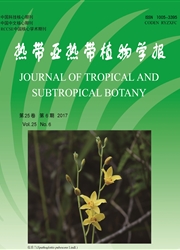

 中文摘要:
中文摘要:
为探讨择伐强度对天然次生林乔木优势树种生态位的影响,运用定量分析方法对不同强度择伐下6种乔木优势树种马尾松(Pinus massoniana)、木荷(Schima superba)、虎皮楠(Daphnipyllum oldhamii)、米槠(Castanopsis carlesii)、甜槠(ceyrei)、黄瑞木(Adinandra millettii)的生态位宽度、生态位相似性比例和生态位重叠进行了测定。结果表明:择伐干扰下,优势种群的生态位宽度随择伐强度增大呈下降趋势;除黄瑞木外,其余5种优势树种的生态位宽度均大于0.5;生态位重叠值大于0.8的种对比例也随择伐强度增大而下降。在皆伐干扰下,优势种群的生态位宽度均小于0.5,生态位重叠值大于0.8的种对比例仅占46.7%。这说明适度择伐(弱度和中度择伐)干扰,有利于保持优势种群在群落中的较大生态位宽度和较强生态适应性。因此,合理择伐有利于中亚热带天然次生林的保护和利用,择伐强度应以弱度或中度为宜。
 英文摘要:
英文摘要:
In order to understand the effects of cutting intensity on niche of tree dominant species in natural secondary forest, the niche breadth, niche similarity proportion and niche overlap of 6 dominant species, such as Pinus massoniana, Schima superba, Daphnipyllum oldhamii, Castanopsis carlesii, C. eyrei and Adinandra millettii, under different selective cutting intensities were studied by quantitative investigation method. The results showed that the niche breadth of dominant species decreased with increment of selective cutting intensity, which were more than 0.5 except ofAdinandra millettii. The species proportion of niche overlap above 0.8 also decreased with increment of selective cutting intensity. Under clear cutting, niche breadth of dominant species were less than 0.5, and species proportion of niche overlap above 0.8 only occupied 46.7%. It suggested that low and middle selective cutting intensity were helpful to keep wide niche breadth and ecological adaptability of dominant species. Therefore, rational selective cutting was beneficial to protect and utilization the mid-subtropical natural secondary forest, and favorite intensity was low or middle selective cutting intensities.
 同期刊论文项目
同期刊论文项目
 同项目期刊论文
同项目期刊论文
 期刊信息
期刊信息
